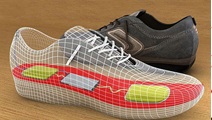Wearable Electronics; The Future Today
POWERED BY ENERGY HARVESTING
By Eng. (Mrs) Nimali T. MedagedaraWearable electronics is an up and coming trend of this decade, and we are at the brink of a new era where wireless, deviceless electronics are coming into the limelight. These devices are currently being developed for different purposes including body vital measurements, communication, military, fashion, and medical treatment etc.
 Even though the real-time sensing, measuring, and analyzing technology has come a long way since its inception, incorporating this technology to a wearable mode still faces many challenges. These include the requirement of weightlessness, mobility, and reduced bulk. In addition to that, any electronic device requires a power source. Therefore, even though the sensing technology is light weight and mobile with the rapid advancements of soft electronics, developing compatible energy devices will be the next challenge for practical applications. This is where “Energy Harvesting” comes into play. This is the process by which energy is obtained (harvested) from external sources and stored for use in small, wireless, and autonomous devices. These external sources include thermal energy, kinetic energy, solar energy etc.
Even though the real-time sensing, measuring, and analyzing technology has come a long way since its inception, incorporating this technology to a wearable mode still faces many challenges. These include the requirement of weightlessness, mobility, and reduced bulk. In addition to that, any electronic device requires a power source. Therefore, even though the sensing technology is light weight and mobile with the rapid advancements of soft electronics, developing compatible energy devices will be the next challenge for practical applications. This is where “Energy Harvesting” comes into play. This is the process by which energy is obtained (harvested) from external sources and stored for use in small, wireless, and autonomous devices. These external sources include thermal energy, kinetic energy, solar energy etc.
Revolutionary energy harvesting methods are currently under research and there are many attractive technologies that can be incorporated into day to day activities.
- Shoes with piezo electric smart soles
 This is an up and coming field of research where piezo electric materials are incorporated into the soles of the shoes. Since walking or running compresses and releases the sole, this in turns generates electricity that can be used to power wearable electronic devices worn by the user or other personal electronics including smart phones, smart watches etc. In addition to energy harvesting, it is an eco-friendly and sustainable power generation technology.
This is an up and coming field of research where piezo electric materials are incorporated into the soles of the shoes. Since walking or running compresses and releases the sole, this in turns generates electricity that can be used to power wearable electronic devices worn by the user or other personal electronics including smart phones, smart watches etc. In addition to energy harvesting, it is an eco-friendly and sustainable power generation technology.
- Tribo electric smart green tires
 This is another novel technology where tribo electric nano generators are used. This technology uses the basic science of where rubbing of two materials generates an opposite electric charge on each of the two materials, depending on the relative electrical affinity of each material. Therefore, by applying this technology to two surfaces that are in relative motion with each other (i.e vehicle tire and road surface), a charge can be accumulated and energy can be harvested consequently.
This is another novel technology where tribo electric nano generators are used. This technology uses the basic science of where rubbing of two materials generates an opposite electric charge on each of the two materials, depending on the relative electrical affinity of each material. Therefore, by applying this technology to two surfaces that are in relative motion with each other (i.e vehicle tire and road surface), a charge can be accumulated and energy can be harvested consequently.
- Clothes with photovoltaic threads
 This innovation consists of solar cells, that are arranged between two conductive threads such that they are connected in parallel, electrical wise. Clothes made from these threads are capable of harvesting solar and light energy, sufficient to power a wearable electronic device.
This innovation consists of solar cells, that are arranged between two conductive threads such that they are connected in parallel, electrical wise. Clothes made from these threads are capable of harvesting solar and light energy, sufficient to power a wearable electronic device.
 However, designing and developing energy harvesting mechanisms and devices face several key challenges, such as choosing a reliable energy storage method and choosing a resource with a good duty cycle with optimum efficiency. The most prominent issue that is currently being faced is the unpredictability and uncertainty of the produced power. Therefore refreshing insights into this field may have a great potential. Unexplored and novel innovative energy harvesting methods could be at the tips of your fingers. As the world is currently over consuming the existing energy sources, with a major energy crisis predicted to occur around 2050, research into developing energy harvesting mechanisms is of inarguable contemporary importance.
However, designing and developing energy harvesting mechanisms and devices face several key challenges, such as choosing a reliable energy storage method and choosing a resource with a good duty cycle with optimum efficiency. The most prominent issue that is currently being faced is the unpredictability and uncertainty of the produced power. Therefore refreshing insights into this field may have a great potential. Unexplored and novel innovative energy harvesting methods could be at the tips of your fingers. As the world is currently over consuming the existing energy sources, with a major energy crisis predicted to occur around 2050, research into developing energy harvesting mechanisms is of inarguable contemporary importance.
Image Sources
- Sphelar YARN - Products - Sphelar Power Corporation
- Power-generating shoes: Creating energy while you walk - Ecofriend
- Wearable Technology | Applications | Flexible Electronics | FlexEnable - FlexEnable
- Wearable Electronics military - Bing images
- Wearable Electronics Medical - Bing images
 Eng. (Mrs) Nimali Tennekoon Medagedara
Eng. (Mrs) Nimali Tennekoon Medagedara
BSc Eng (Hons) (Peradeniya), MPhil (SHU),
MIE (SL), C.Eng., MIEEE, Member of SLAAS
Senior Lecturer, Department of Mechanical Engineering
The Open University of Sri Lanka.





